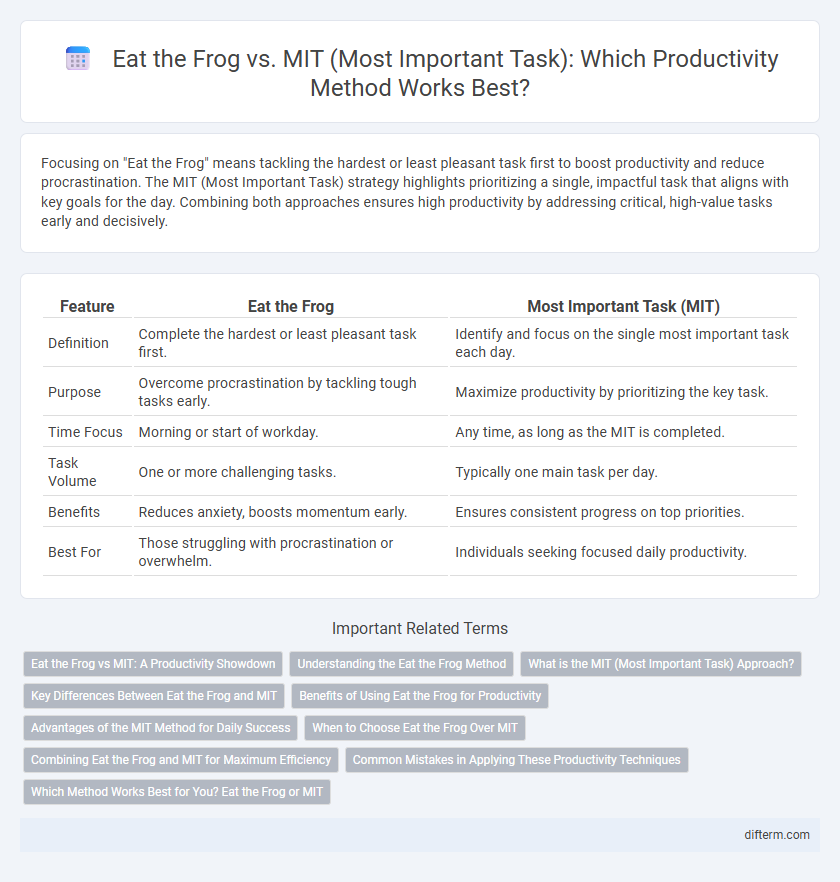Focusing on "Eat the Frog" means tackling the hardest or least pleasant task first to boost productivity and reduce procrastination. The MIT (Most Important Task) strategy highlights prioritizing a single, impactful task that aligns with key goals for the day. Combining both approaches ensures high productivity by addressing critical, high-value tasks early and decisively.
Table of Comparison
| Feature | Eat the Frog | Most Important Task (MIT) |
|---|---|---|
| Definition | Complete the hardest or least pleasant task first. | Identify and focus on the single most important task each day. |
| Purpose | Overcome procrastination by tackling tough tasks early. | Maximize productivity by prioritizing the key task. |
| Time Focus | Morning or start of workday. | Any time, as long as the MIT is completed. |
| Task Volume | One or more challenging tasks. | Typically one main task per day. |
| Benefits | Reduces anxiety, boosts momentum early. | Ensures consistent progress on top priorities. |
| Best For | Those struggling with procrastination or overwhelm. | Individuals seeking focused daily productivity. |
Eat the Frog vs MIT: A Productivity Showdown
Eat the Frog emphasizes tackling the most challenging task first to overcome procrastination and boost morning productivity. MIT (Most Important Task) prioritizes completing the single most impactful task for the day, ensuring focused energy on high-value work. Both strategies enhance productivity by limiting distractions and fostering disciplined task execution aligned with personal and professional goals.
Understanding the Eat the Frog Method
The Eat the Frog method emphasizes tackling the most challenging or important task first thing in the day to maximize productivity and reduce procrastination. By completing the hardest task early, individuals create momentum and a sense of accomplishment that drives efficiency throughout the day. This approach aligns with productivity principles but specifically prioritizes confronting the biggest task before moving on to others.
What is the MIT (Most Important Task) Approach?
The MIT (Most Important Task) approach prioritizes the single most critical task that will have the greatest impact on your goals, ensuring focused energy and time allocation. By identifying and completing this high-value activity first, productivity increases as distractions and less important tasks are minimized. This method enhances decision-making and momentum, driving consistent progress toward meaningful outcomes.
Key Differences Between Eat the Frog and MIT
Eat the Frog emphasizes tackling the most challenging or unpleasant task first each day to overcome procrastination, while MIT (Most Important Task) focuses on identifying and completing the single highest-priority task regardless of difficulty. Eat the Frog leverages psychological momentum by addressing fear-driven tasks upfront, whereas MIT promotes strategic productivity by prioritizing impact over emotional resistance. The key difference lies in Eat the Frog's behavioral approach to task avoidance, contrasting with MIT's results-oriented prioritization framework.
Benefits of Using Eat the Frog for Productivity
Eat the Frog enhances productivity by encouraging immediate focus on the most challenging task, reducing procrastination and mental clutter. Prioritizing this single, high-impact activity early in the day boosts motivation and momentum for subsequent tasks. This technique streamlines decision-making and leverages peak energy levels, leading to more efficient and effective work performance.
Advantages of the MIT Method for Daily Success
The MIT (Most Important Task) method enhances daily productivity by pinpointing and prioritizing critical activities that yield the highest impact on goal achievement. This approach reduces decision fatigue by clarifying which task demands immediate focus, ensuring consistent progress on key objectives. Unlike the Eat the Frog technique, MIT offers flexibility to adapt task priorities based on evolving deadlines and shifting project demands.
When to Choose Eat the Frog Over MIT
Eat the frog is ideal when facing a high-impact, daunting task that tends to cause procrastination, ensuring it gets completed first to boost momentum. MIT works best for daily prioritization of several important tasks, but eat the frog is preferable for tackling the single most challenging task that can block all progress. Choosing eat the frog over MIT enhances productivity by eliminating decision fatigue and overcoming avoidance of critical but unpleasant tasks early in the day.
Combining Eat the Frog and MIT for Maximum Efficiency
Combining Eat the Frog with the Most Important Task (MIT) method turbocharges productivity by prioritizing the toughest, highest-impact task first thing in the day, leveraging peak cognitive energy. This approach minimizes procrastination and ensures critical goals drive daily progress, optimizing work output and time management. Integrating both strategies creates a powerful workflow that targets efficiency, motivation, and effective task completion.
Common Mistakes in Applying These Productivity Techniques
Common mistakes in applying Eat the Frog and Most Important Task (MIT) techniques include misidentifying tasks that truly impact productivity, often prioritizing low-value activities under the guise of urgency. Many individuals struggle with consistency, failing to integrate these methods into daily routines, which diminishes their effectiveness. Overloading the MIT list or procrastinating on the "frog" leads to reduced focus and incomplete high-priority work, undermining overall productivity gains.
Which Method Works Best for You? Eat the Frog or MIT
Choosing between Eat the Frog and MIT (Most Important Task) depends on individual work patterns and productivity goals. Eat the Frog encourages tackling the hardest task first to overcome procrastination, while MIT focuses on identifying and completing one high-priority task daily for steady progress. Experimenting with both methods helps determine which approach aligns better with your energy levels and project demands, optimizing productivity results.
Eat the frog vs MIT (Most Important Task) Infographic

 difterm.com
difterm.com